Caryn’s Thoughts
 When we think of war, we think mostly of battle, but we should also think of the spies that gather intel. Most often, spies are men and women who have been carefully trained to avoid the enemy, and very possibly to live among the enemy without being detected, so they can hear the plans of the enemy and pass the information to the intelligence community, so it can be used against the enemy so as to win the war. There is, however, another kind of spy that has long been used in war, and was used especially during World War I and World War II…the pigeon. Now this is a spy I would have never have imagined.
When we think of war, we think mostly of battle, but we should also think of the spies that gather intel. Most often, spies are men and women who have been carefully trained to avoid the enemy, and very possibly to live among the enemy without being detected, so they can hear the plans of the enemy and pass the information to the intelligence community, so it can be used against the enemy so as to win the war. There is, however, another kind of spy that has long been used in war, and was used especially during World War I and World War II…the pigeon. Now this is a spy I would have never have imagined.
The reason pigeons caught the attention of the military was that they were trained to fly home…from wherever they were dropped off. I have no idea how they can do that, but they can and do. The spy pigeons went in as Operation Columba, during some of the bloodiest years of World War II. The idea was to drop cages attached to parachutes into the occupied areas of France, with the hope that the people and resistance members, as well as soldiers could attach messages with critical intel on the enemy locations to the pigeons, who would then be sent back to their home base. There, soldiers would be 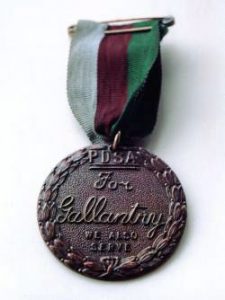 waiting to get the messages to the intelligence community. The plan was perfect, but very risky for the pigeons. So many dangers awaited them…the guns of the enemy, not being found and dying in the cage, and one most of us wouldn’t think of…hungry people. The operation, on its face, was deceptively simple. The British planes dropped 16,000 homing pigeons over occupied Europe during the course of the war, parachuted in small baskets with rice paper, containing a list of questions to be answered by civilians who found them, tucked into canisters tied to their legs. Then the pigeons were to be sent home. Many were lost to the perils in their way, but there were a good number who made it back. A some were decorated with the Dickin Medal for their service…32 pigeons in all were awarded the medal. Pigeon Soldiers like “Winkie” (1943), “Commando” (1944), “Paddy” (1944), “William of Orange” (1944), Mary of Exeter (1945), “G.I. Joe” (1946), Gustav (1944), and Beach Comber (1944), just to name a few. The homing pigeons were donated by their owners…no small sacrifice when you consider that so many lost their lives during the operation. Still, like their human counterparts, the pigeons did their duty, and made their owners proud.
waiting to get the messages to the intelligence community. The plan was perfect, but very risky for the pigeons. So many dangers awaited them…the guns of the enemy, not being found and dying in the cage, and one most of us wouldn’t think of…hungry people. The operation, on its face, was deceptively simple. The British planes dropped 16,000 homing pigeons over occupied Europe during the course of the war, parachuted in small baskets with rice paper, containing a list of questions to be answered by civilians who found them, tucked into canisters tied to their legs. Then the pigeons were to be sent home. Many were lost to the perils in their way, but there were a good number who made it back. A some were decorated with the Dickin Medal for their service…32 pigeons in all were awarded the medal. Pigeon Soldiers like “Winkie” (1943), “Commando” (1944), “Paddy” (1944), “William of Orange” (1944), Mary of Exeter (1945), “G.I. Joe” (1946), Gustav (1944), and Beach Comber (1944), just to name a few. The homing pigeons were donated by their owners…no small sacrifice when you consider that so many lost their lives during the operation. Still, like their human counterparts, the pigeons did their duty, and made their owners proud.
The pigeons did other work, besides just delivering messages. The military equipped some with tiny cameras and they pigeons took reconnaissance photos as they flew back to their home base. The military didn’t have drones in those days, and planes flying “low and slow” would surly be shot down, so the pigeons served as 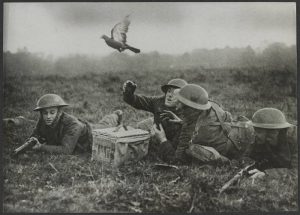 drones in their day too. Most of us think of homing pigeons as being a hobby, and I suppose it started out as that for most of the handlers, but then they grew to love their pigeons…just like family. Each loss was felt deeply, and each successful return met with great relief. They were proud of their very special soldiers, and we as a nation should be too. It gives me a whole new view of pigeons, which I have always enjoyed watching whenever I am in downtown Casper, where we have a beautiful flock of them that grace the skies above town…dipping and soaring high above the buildings, as if in play, but we should remember that at any time, they could be called upon to serve in a different capacity, if the need arose.
drones in their day too. Most of us think of homing pigeons as being a hobby, and I suppose it started out as that for most of the handlers, but then they grew to love their pigeons…just like family. Each loss was felt deeply, and each successful return met with great relief. They were proud of their very special soldiers, and we as a nation should be too. It gives me a whole new view of pigeons, which I have always enjoyed watching whenever I am in downtown Casper, where we have a beautiful flock of them that grace the skies above town…dipping and soaring high above the buildings, as if in play, but we should remember that at any time, they could be called upon to serve in a different capacity, if the need arose.

 My niece, Dustie Masterson, like most mothers of mostly girls, and one boy, says that her “Bubba,” as she calls her son, Matthew befuddles her quite often with his “boy” ways. While I had two daughters, I had three grandsons and one granddaughter, all of who I was very involved with, so I can totally relate to Dustie’s dilemma with Matt. Dustie’s befuddlement comes from not being raised with a man in the house, so I’m sure that my nephew, her husband, Rob adds to that befuddlement too. He certainly did for me when he was a kid. As to Matt, he loves to “torture” his sisters, Raelynn and Anna, with whom he is the middle child. Boy torture can be enough to make the sisters want to “sell” their brother, as my granddaughter spent years wanting to do with her brother. Matt does torture his sisters, but if anyone outside of their family even thinks about even slightly upsetting the girls…look out!! Matt will take them out…seriously!! When he isn’t “torturing” his sisters, Matt is very into online gaming, and seriously competes with his buddies. He likes it so much, that he asked his Uncle Dave Balcerzak…our family computer guru, to build him a gaming computer. Dave did a great job, and Dustie tells me “That thing is awesome.”
My niece, Dustie Masterson, like most mothers of mostly girls, and one boy, says that her “Bubba,” as she calls her son, Matthew befuddles her quite often with his “boy” ways. While I had two daughters, I had three grandsons and one granddaughter, all of who I was very involved with, so I can totally relate to Dustie’s dilemma with Matt. Dustie’s befuddlement comes from not being raised with a man in the house, so I’m sure that my nephew, her husband, Rob adds to that befuddlement too. He certainly did for me when he was a kid. As to Matt, he loves to “torture” his sisters, Raelynn and Anna, with whom he is the middle child. Boy torture can be enough to make the sisters want to “sell” their brother, as my granddaughter spent years wanting to do with her brother. Matt does torture his sisters, but if anyone outside of their family even thinks about even slightly upsetting the girls…look out!! Matt will take them out…seriously!! When he isn’t “torturing” his sisters, Matt is very into online gaming, and seriously competes with his buddies. He likes it so much, that he asked his Uncle Dave Balcerzak…our family computer guru, to build him a gaming computer. Dave did a great job, and Dustie tells me “That thing is awesome.”
Dustie and Rob really count on Matthew for a lot. The family recently got a kitten named Pita. Pita is very small and got under Rob’s foot while he was getting ready for work. He stepped on her very badly. Rob had to go to work, but Pita needed to get to their vet in Glenrock, it was an emergency. Dustie ran downstairs and woke Matthew up, saying, “We gotta go now.” He didn’t argue, but got right up and they left to make the 20 minute drive. When they arrived, Dustie realized two things. She had forgotten shoes, and Matt, remembering his shoes, forgot his shirt. She borrowed his shoes, and they went in. Matt had held the kitten the entire way, keeping both the kitten and his mom calm, praying and telling his mom that Pita would be ok. By God’s grace Pita lived through the ordeal.
Matt loves to cook. Dustie is going to have to go to Rock Springs to help with another store for a few days, and Matt is going to do all the cooking. He already has the entire menu planned out. Since schools closed because of Covid-19 Matt walks to Dustie’s work just about everyday. The girls at work love seeing him (and so does his mom). Matt loves to experiment with wild hair colors, and the girls at Dustie’s work love to see what color it is now. Dustie says that Matt is very particular about his appearance. He likes the name brands and when we go clothing shopping, while he gets the same amount as the girls for shopping, he always chooses to spend it on a 
 few items. As Matt grow up, he has also become very protective toward his mom. If he thinks something is heavy, he carries it. If she is headed out after dark, he goes with her. He has grown up to be quite like his dad…protective over those he cares about. Dustie is having to fight the urge to always shield him and allow him learn to shield those around him. He is becoming quite a young man. Today is Matt’s 15th birthday. Happy birthday Matt!! Have a great day!! We love you!!
few items. As Matt grow up, he has also become very protective toward his mom. If he thinks something is heavy, he carries it. If she is headed out after dark, he goes with her. He has grown up to be quite like his dad…protective over those he cares about. Dustie is having to fight the urge to always shield him and allow him learn to shield those around him. He is becoming quite a young man. Today is Matt’s 15th birthday. Happy birthday Matt!! Have a great day!! We love you!!

 My great grand-niece, Alice Green is the sweet little bonus baby that my grand-nephew Jake Harman got when he married her mother, Melanie. Alice is a wonderful little girl, and I loved her immediately. She is always happy and wants to make sure that those around her are happy too, and all it takes is one smile from her, and you are happy too.
My great grand-niece, Alice Green is the sweet little bonus baby that my grand-nephew Jake Harman got when he married her mother, Melanie. Alice is a wonderful little girl, and I loved her immediately. She is always happy and wants to make sure that those around her are happy too, and all it takes is one smile from her, and you are happy too.
Alice was 2 years old when her mom met her step-dad. She loved having a dad in the house again, and they were best friends, but there was something that was missing…siblings. Alice didn’t have siblings, and she really wanted them. She knew that other kids had them, and it was hard for her to understand why she didn’t, but for Alice, it wasn’t going to be that way for long. By the time Alice was 3 years old, her little sister, Izabella came along, and then when she was 5 years old, her little brother, Jaxx was added to the family. She suddenly felt like she was the most blessed little girl in the world. She loved being the big sister.
Alice is 7 years old now, and growing up fast, but she still loves her siblings very much. She may get tired of  their little kid ways when she is a teenager, but for now they are her best friends. More so than ever this year, because school was cut short, and friends were set aside for the Covid-19 Pandemic. She got to spend the whole day with them, like it was summer for 5½ months instead of 3 months. It was the longest summer, and the best summer. I don’t know if all the parents thought it was a great thing, but for the kids it was the best thing to happen since sliced bread. With school starting soon, I’m sure the kids will miss it now that it’s over. Today is Alice’s 7th birthday. Happy birthday Alice!! Have a great day!! We love you!!
their little kid ways when she is a teenager, but for now they are her best friends. More so than ever this year, because school was cut short, and friends were set aside for the Covid-19 Pandemic. She got to spend the whole day with them, like it was summer for 5½ months instead of 3 months. It was the longest summer, and the best summer. I don’t know if all the parents thought it was a great thing, but for the kids it was the best thing to happen since sliced bread. With school starting soon, I’m sure the kids will miss it now that it’s over. Today is Alice’s 7th birthday. Happy birthday Alice!! Have a great day!! We love you!!

 When Dave Balcerzak married my niece, Chantel, he brought to the marriage two children, Keifer and Katy. Chantel also brought to the marriage two children, Jake and Siara. When they got married in 2002, the children were between the ages of 14 and 7 years. They instantly became a blended family, and they all got along very well. Dave really loves kids, and he was an excellent dad to Chantel’s kids, as well as to his own. It isn’t easy to raise kids, especially during the teenaged years, and it’s even harder to raise someone else’s kids, but Dave took it all in stride, and Chantel’s kids love him very much. They consider him really more their dad, than their own dad is.
When Dave Balcerzak married my niece, Chantel, he brought to the marriage two children, Keifer and Katy. Chantel also brought to the marriage two children, Jake and Siara. When they got married in 2002, the children were between the ages of 14 and 7 years. They instantly became a blended family, and they all got along very well. Dave really loves kids, and he was an excellent dad to Chantel’s kids, as well as to his own. It isn’t easy to raise kids, especially during the teenaged years, and it’s even harder to raise someone else’s kids, but Dave took it all in stride, and Chantel’s kids love him very much. They consider him really more their dad, than their own dad is.
One of the blessings of having children, is the entrance of the next generation…grandchildren. In a blended family, the grandchildren are also blended. The first grandchild to come along, was a bonus baby names Alice Green. She joined Chantel’s son Jake Harman’s family when he married Alice’s mom, Melanie. Alice took to Dave almost instantly. She adored him. Alice was soon joined by sister, Izabella Harman and brother, Jaxx Harman. Dave was relishing in grandfatherhood. Then, Dave’s son, Keifer and his wife, Katie welcomed their daughter, Reece Balcerzak. Reece gave the family a bit of a scare, by arriving quite early, but she was a fighter, and all went well. Chantel’s daughter, Siara and her husband, Nick Olsen gave birth to Alec Olsen, who after 3 months, went to live in Heaven, breaking the hearts of all of his family, who miss him very much. Finally, Dave’s daughter, Katy Balcerzak and her fiancé, Dylan Herr, gave birth to their son, Max. Dave and Chantel’s blended family is going through more blending, as the new grandchildren have arrived. Life is so sweet, when grandchildren are involved. I know that the future will bring more grandchildren, and great happiness to this wonderful blended family that Dave and Chantel have so lovingly created.


Dave has been a wonderful addition to our family. He has a heart of gold, and the capacity to love everyone, a trait that has endeared him to all of us. It’s not every parent who has the ability to love their step-children as much as their own children, but for Dave they are all his children, and he will give the best of himself for all of them, and the blessing he has been to them, is now being returned to him, many times over. Today is Dave’s birthday. Happy birthday Dave!! Have a great day!! We love you!!

 My nephew, JD Parmely is a hard-working man. He is a mechanic at Ken’s Auto Repair. Like most mechanics shops, there are busy days, and slower days, but there is almost never a dead day. People’s cars have to be maintained. We all have places we need to be, and if our cars don’t run well, we have a problem. That is where the mechanics of this world really shine. JD comes from a long line of mechanics, including his dad, Keith Parmely; grandpa, Walt Schulenberg; uncles, Bob and Ron Schulenberg; brothers, Barry Schulenberg and Eric Parmely. Together these men have helped each other with more vehicles than any of them could ever count. There is never a problem that one might have that one of the others doesn’t know how to fix. It is a blessing that mechanics share.
My nephew, JD Parmely is a hard-working man. He is a mechanic at Ken’s Auto Repair. Like most mechanics shops, there are busy days, and slower days, but there is almost never a dead day. People’s cars have to be maintained. We all have places we need to be, and if our cars don’t run well, we have a problem. That is where the mechanics of this world really shine. JD comes from a long line of mechanics, including his dad, Keith Parmely; grandpa, Walt Schulenberg; uncles, Bob and Ron Schulenberg; brothers, Barry Schulenberg and Eric Parmely. Together these men have helped each other with more vehicles than any of them could ever count. There is never a problem that one might have that one of the others doesn’t know how to fix. It is a blessing that mechanics share.
JD works long hours at his job, and then goes home, eats dinner, and…you got it, works on his own cars in his garage, or helps our his uncles or brothers on their projects, or works on cars for friends. Sometimes, he doesn’t quit until late in the evening…when he finally wears himself out. Then he goes to bed, so he’s ready to start all over again the next day. JD really is a 24-7 Mechanic. It’s my guess that he even dreams about working on one of the vehicles he has lined out to work on next…planning just what he needs to do on it. Still, JD is so dedicated that if someone called him in the middle of the night, JD would go and see what he could do to help. It’s just his nature.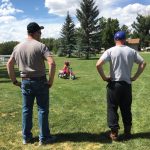

There is one other thing that JD is all about, however, and in reality his 3 nieces, Reagan, Hattie, and Maeve Parmely, and his nephew, Bowen Parmely are at the top of his list of priorities. JD loves being and uncle, and playing with the kids. He sees them as much as he can. He really enjoys playing with the kids, and they think he’s great too. When JD is around, the kids have a great time, because JD like many men, is a big kid at heart. Today is JD’s birthday. Happy birthday JD!! Have a great day!! We love you!!
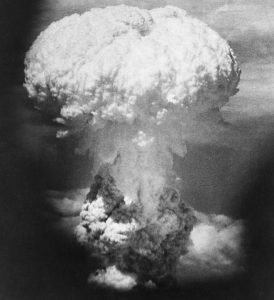 When the first atomic bomb exploded over Hiroshima on August 6, 1945, the city was instantly in ruins. The bomb immediately ended the lives of 80,000 of the 350,000 people of Hiroshima.
When the first atomic bomb exploded over Hiroshima on August 6, 1945, the city was instantly in ruins. The bomb immediately ended the lives of 80,000 of the 350,000 people of Hiroshima.
Tsutomu Yamaguchi was born on March 16, 1916 in Nagasaki, Japan, where he grew up and in the 1930s, joined Mitsubishi Heavy Industries working as a draftsman designing oil tankers. Then in the summer of 1945, he was in Hiroshima for a three-month-long business trip. That trip was at its conclusion on August 6th, and he was preparing to leave the city with two colleagues, Akira Iwanaga and Kuniyoshi Sato. They were on their way to the train station when Yamaguchi realized he had forgotten his hanko (a type of identification stamp common in Japan) and returned to his workplace to get it. That one act would have monumental consequences.
At 8:15am, Yamaguchi was walking towards the docks when the American B-29 bomber Enola Gay dropped the Little Boy atomic bomb near the center of the city, only 1.9 miles away. Yamaguchi recalls seeing the bomber and two small parachutes, before there was “a great flash in the sky, and I was blown over”. The explosion 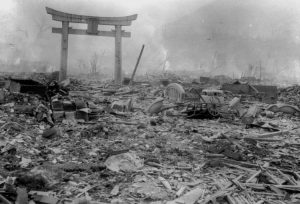 ruptured his eardrums, blinded him temporarily, and left him with serious radiation burns over the left side of the top half of his body. After recovering, he crawled to a shelter and, having rested, he set out to find his colleagues. They had also survived and together they spent the night in an air-raid shelter before returning to Nagasaki the following day. In Nagasaki, he received treatment for his wounds and, despite being heavily bandaged, he reported for work on August 9th. As soon as he could get out, Yamaguchi went back home to Nagasaki.
ruptured his eardrums, blinded him temporarily, and left him with serious radiation burns over the left side of the top half of his body. After recovering, he crawled to a shelter and, having rested, he set out to find his colleagues. They had also survived and together they spent the night in an air-raid shelter before returning to Nagasaki the following day. In Nagasaki, he received treatment for his wounds and, despite being heavily bandaged, he reported for work on August 9th. As soon as he could get out, Yamaguchi went back home to Nagasaki.
Ironically, Yamaguchi arrived in Nagasaki on August 9, 1945. Back at his office, Yamaguchi was describing the blast in Hiroshima to his supervisor at 11:00am, when the American bomber Bockscar dropped the Fat Man atomic bomb over the city. Yamaguchi’s workplace again put him 1.9 miles from ground zero. This time he was unhurt by the explosion, however, he was unable to replace his now ruined bandages and he suffered from a high fever and continuous vomiting for over a week. I’m sure he felt like he was dying. Technically, some 100 people were known to have been 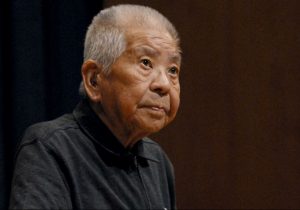 affected by both bombings. In 1957, Yamaguchi was recognized as a hibakusha “explosion-affected person” of the Nagasaki bombing. It is unknown, why the government didn’t recognize the other survivors. In 2006 Yamaguchi addressed the United Nations General Assembly in New York City in support of nuclear disarmament. It was not until March 24, 2009, that the government of Japan officially recognized his presence in Hiroshima three days earlier, as well. He died of stomach cancer on January 4, 2010, at the age of 93. Yamaguchi was the only “officially” documented survivor of both the August 6, 1945 Hiroshima and the August 9, 1945 Nagasaki atomic bombings during World War II.
affected by both bombings. In 1957, Yamaguchi was recognized as a hibakusha “explosion-affected person” of the Nagasaki bombing. It is unknown, why the government didn’t recognize the other survivors. In 2006 Yamaguchi addressed the United Nations General Assembly in New York City in support of nuclear disarmament. It was not until March 24, 2009, that the government of Japan officially recognized his presence in Hiroshima three days earlier, as well. He died of stomach cancer on January 4, 2010, at the age of 93. Yamaguchi was the only “officially” documented survivor of both the August 6, 1945 Hiroshima and the August 9, 1945 Nagasaki atomic bombings during World War II.

 My grand niece, Katie Balcerzak is a sweet girl, who absolutely loves just being a mom. She came by that title in a little bit scary fashion, when her daughter, Reece was born over two months early. It was a very scary time for Katie and my grand nephew, Kiefer. It was a time of emergency, and yet it was a time of miracles. They didn’t know what the future would hold for them, but their little girl was a fighter, and she survived. It was during this time that I also realized just how strong Katie and Keifer were. They were living through an incredibly difficult period in their lives, but they stood strong for their little girl. The weeks went by, Christmas passed, then New Years…Valentine’s Day was fast approaching, and then Reece was well enough to go home. Katie and Keifer breathed a sigh of relief…slightly. The worry over premature babies does not leave the parents quickly, but now after the passage of time, they feel safe.
My grand niece, Katie Balcerzak is a sweet girl, who absolutely loves just being a mom. She came by that title in a little bit scary fashion, when her daughter, Reece was born over two months early. It was a very scary time for Katie and my grand nephew, Kiefer. It was a time of emergency, and yet it was a time of miracles. They didn’t know what the future would hold for them, but their little girl was a fighter, and she survived. It was during this time that I also realized just how strong Katie and Keifer were. They were living through an incredibly difficult period in their lives, but they stood strong for their little girl. The weeks went by, Christmas passed, then New Years…Valentine’s Day was fast approaching, and then Reece was well enough to go home. Katie and Keifer breathed a sigh of relief…slightly. The worry over premature babies does not leave the parents quickly, but now after the passage of time, they feel safe.
Katie had never wanted anything more than she wanted to be a mom. Almost losing that chance made having their baby girl that much more amazing, and now, each day is a miracle and a gift. Katie knew that this was her calling. She is a mom, and she rejoices at the life she now has, with the love of her life, and the precious child of that love. I could say that for a time Katie had other dreams for her life, but she did not. Before becoming a mom, she was a pre-school teacher. Her love of children has always been there. Any career she might have wanted tended to focus on children. She just has the heart of a mom, and children are her priority. I love seeing pictures of Katie and Reece together. You can feel the love and the bond they share.

 Katie, is more than just a mom, though. She is a best friend. She is thoughtful, and very caring. Many is the time when she has posted something or said something that, whether she knew it or not, I or someone else really needed to hear right then. An encouraging word, spoken or posted at just the right moment, can be so powerful. It has the power to heal, and bring joy to a heart that is hurting. Having the ability to deliver those words at just the right time is a great gift. It is one that Katie has, and it is to her credit. Today is Katie’s birthday. Happy birthday Katie!! Have a great day!! We love you!!
Katie, is more than just a mom, though. She is a best friend. She is thoughtful, and very caring. Many is the time when she has posted something or said something that, whether she knew it or not, I or someone else really needed to hear right then. An encouraging word, spoken or posted at just the right moment, can be so powerful. It has the power to heal, and bring joy to a heart that is hurting. Having the ability to deliver those words at just the right time is a great gift. It is one that Katie has, and it is to her credit. Today is Katie’s birthday. Happy birthday Katie!! Have a great day!! We love you!!
 World War I brought a new kind of fighting…trench warfare. It actually started on September 15, 1914, when a battle dragged on far longer that anyone ever expected. The Battle of the Marne was expected to be over quickly, but the soldiers had other ideas. Allied troops halted the steady German push through Belgium and France that had proceeded over the first month of World War I, but neither side was willing to give up. Allied and German forces begin digging the first trenches on the Western Front. They were in this for the long haul. It was the beginning of trench warfare…a tactic that went on until 1918.
World War I brought a new kind of fighting…trench warfare. It actually started on September 15, 1914, when a battle dragged on far longer that anyone ever expected. The Battle of the Marne was expected to be over quickly, but the soldiers had other ideas. Allied troops halted the steady German push through Belgium and France that had proceeded over the first month of World War I, but neither side was willing to give up. Allied and German forces begin digging the first trenches on the Western Front. They were in this for the long haul. It was the beginning of trench warfare…a tactic that went on until 1918.
Trench warfare was a good tactic to use for the most part, because it provided some protection from the enemy forces on the ground. The air war during World War I was much different that the air war of World War II. There were no heavy bombers, and while 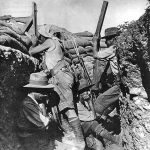 there were fighter planes, most of the war was fought on the ground…in the trenches. Soldier had some place to hide from the bullets that were flying by them at lightning speed. The men often used periscopes to safely see over the sides of the trenches. There is no completely safe way to fight hand to hand combat, but the trenches were often the best protection available. Still, while the trenches did provide a measure of protection, they had their dangers too. First, the trenches had to be dug, and the digging might easily be done with the enemy coming up on you fast, or worse yet, already there. The trenches were dug by the men, in ground that was often hard and rocky, but the job had to be done, and then the battle still had to be fought, no matter how weary the soldiers were…no matter how much they needed sleep, in a warm bed.
there were fighter planes, most of the war was fought on the ground…in the trenches. Soldier had some place to hide from the bullets that were flying by them at lightning speed. The men often used periscopes to safely see over the sides of the trenches. There is no completely safe way to fight hand to hand combat, but the trenches were often the best protection available. Still, while the trenches did provide a measure of protection, they had their dangers too. First, the trenches had to be dug, and the digging might easily be done with the enemy coming up on you fast, or worse yet, already there. The trenches were dug by the men, in ground that was often hard and rocky, but the job had to be done, and then the battle still had to be fought, no matter how weary the soldiers were…no matter how much they needed sleep, in a warm bed.
Sometimes, the the worst danger would become a reality, and it often had nothing to do with the enemy. 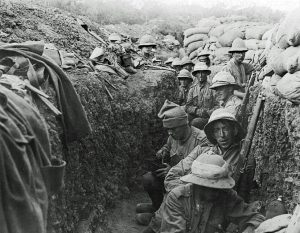 Sometimes, there were cave-ins of the trenches. If the soldiers caught in the cave-in were lucky, their fellow soldiers saw the cave-in, and quickly came to their fellow soldiers’ rescue. Sometimes, they could dig them out in time to save their lives. Unfortunately, all too often, they were too late. Worse yet, was the possibility that the battle was still raging, and while the soldiers knew of the peril their fellow soldiers were in, there was nothing they could do for them at that time, and when they could get too them, it was too late. Sometimes, no one was around to see the cave-in, and the bodies would not be found for months, or years, and sometimes never. Sometimes, these men would forever be listed as missing and presumed dead. And that was the worst fate of all.
Sometimes, there were cave-ins of the trenches. If the soldiers caught in the cave-in were lucky, their fellow soldiers saw the cave-in, and quickly came to their fellow soldiers’ rescue. Sometimes, they could dig them out in time to save their lives. Unfortunately, all too often, they were too late. Worse yet, was the possibility that the battle was still raging, and while the soldiers knew of the peril their fellow soldiers were in, there was nothing they could do for them at that time, and when they could get too them, it was too late. Sometimes, no one was around to see the cave-in, and the bodies would not be found for months, or years, and sometimes never. Sometimes, these men would forever be listed as missing and presumed dead. And that was the worst fate of all.

 When my grand nephew, Jake Harman married his wife Melanie, everything changed for him. He his the jackpot that day, because Melanie is the perfect life partner for him. I have never seen him happier than at that time…if you don’t count every day since, because with Melanie as his wife, life just keeps getting better every day. Jake and Melanie are probably pretty close to polar opposites, and that is exactly what Jake needed. Melanie can always calm him when he gets stressed out. She’s been able to do that from the start of their relationship. Jake has always been more high-strung, but since Melanie came into his life, he seems…well, at peace. Melanie has that effect on people.
When my grand nephew, Jake Harman married his wife Melanie, everything changed for him. He his the jackpot that day, because Melanie is the perfect life partner for him. I have never seen him happier than at that time…if you don’t count every day since, because with Melanie as his wife, life just keeps getting better every day. Jake and Melanie are probably pretty close to polar opposites, and that is exactly what Jake needed. Melanie can always calm him when he gets stressed out. She’s been able to do that from the start of their relationship. Jake has always been more high-strung, but since Melanie came into his life, he seems…well, at peace. Melanie has that effect on people.
Melanie is the mother to three beautiful children, Alice, Izabella, and Jaxx, and they feel very blessed to have her for their mom. Melanie makes life fun. The children are encouraged to laugh and play, and even be noisy. Many parents just want their kids to be quiet, and I’m sure there are times when Meanie and Jake feel the same, but just as often, they love to see the children laughing and playing rambunctiously. Still, they are sweet, well-behaved children…a credit to their parents. She also enjoys making their home special for her whole family. Her creative ideas are just beautiful.
Melanie and Jake are active in their church, where Jake is a youth pastor. This year, after things had settled down from the Covid-19 pandemic, and because a Vacation Bible School, or church camp were out of the question, they were able to take a small group on a short camping trip to the lake for a few days. They had 
 a great time, and the youth appreciated getting to do something new, when so much distancing is the norm.
a great time, and the youth appreciated getting to do something new, when so much distancing is the norm.
Melanie has made a wonderful home for her family, and she is loved by all who know her. Jakes whole family loves her sweet ways, and they way she has improved Jake’s life and filled it will love. I know that the rest of their lives will also be blessed years of growth, harmony, and love. Today is Melanie’s birthday. Happy birthday Melanie!! Have a great day!! We love you!!
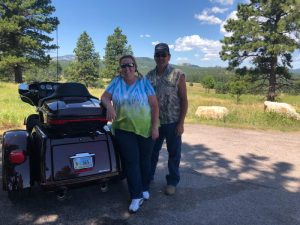
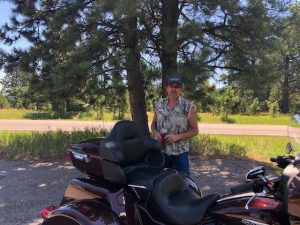 My brother-in-law, Mike Reed has been having a very busy summer. In addition to working as Area Manager for Sinclair Oil Corporation, he and my sister, Caryl are working on getting their retirement home ready outside of Casper. Their new home is complete, and now they have been working on the property. They have been planting grass, trees, and flowers, as well as decorating with some bronze statues of several animals, like elk and antelope. The yard looks really nice. Mike has worked really hard at fixing their place up. From putting in a road, to fencing, to planting grass, and now to becoming an oat farmer with the full on irrigation system necessary to make that successful. These are just a few of the projects Mike has turned into reality. He still has a number of future plans that will turn their ranch into a wonderful place for them to live.
My brother-in-law, Mike Reed has been having a very busy summer. In addition to working as Area Manager for Sinclair Oil Corporation, he and my sister, Caryl are working on getting their retirement home ready outside of Casper. Their new home is complete, and now they have been working on the property. They have been planting grass, trees, and flowers, as well as decorating with some bronze statues of several animals, like elk and antelope. The yard looks really nice. Mike has worked really hard at fixing their place up. From putting in a road, to fencing, to planting grass, and now to becoming an oat farmer with the full on irrigation system necessary to make that successful. These are just a few of the projects Mike has turned into reality. He still has a number of future plans that will turn their ranch into a wonderful place for them to live.
This year, Mike and Caryl decided to grow oats on their land, after talking to a neighbor who wants to buy the oats from them. It’s a really cool thing, because they crop is already sold, and all they have to do is water it and harvest it for the neighbor. Their plan has always been to have a working ranch, so they will have an income when Mike retires. Caryl retired a couple of years ago. They has boarded horses on their place, but they don’t own any horses right now. I think that might be a plan for the future, because Caryl has always loved horses. I think Mike does too.
Mike has worked for Sinclair Oil Corporation for long time now, and so has good vacation time available each year. This year, they decided to go to the Black Hills for a few days, riding the trike Mike got Caryl for her birthday. They had a blast!! In fact they had so much fun that they decided to head up through Beartooth pass, Red Lodge, and Cook City in northwestern Wyoming. They are really enjoying that trip. For this one, they 
 trailered the trike, because of the mountain roads, and cool weather in Beartooth pass. I know this is just two of many future trip for both of them. Once Mike retires, they will have lots of free time to travel, entertain at their ranch, and reconnect with the family that lives here a little more often. We all look forward to that. Today is Mike’s birthday. Happy birthday Mike!! Have a great day!! We love you!!
trailered the trike, because of the mountain roads, and cool weather in Beartooth pass. I know this is just two of many future trip for both of them. Once Mike retires, they will have lots of free time to travel, entertain at their ranch, and reconnect with the family that lives here a little more often. We all look forward to that. Today is Mike’s birthday. Happy birthday Mike!! Have a great day!! We love you!!

